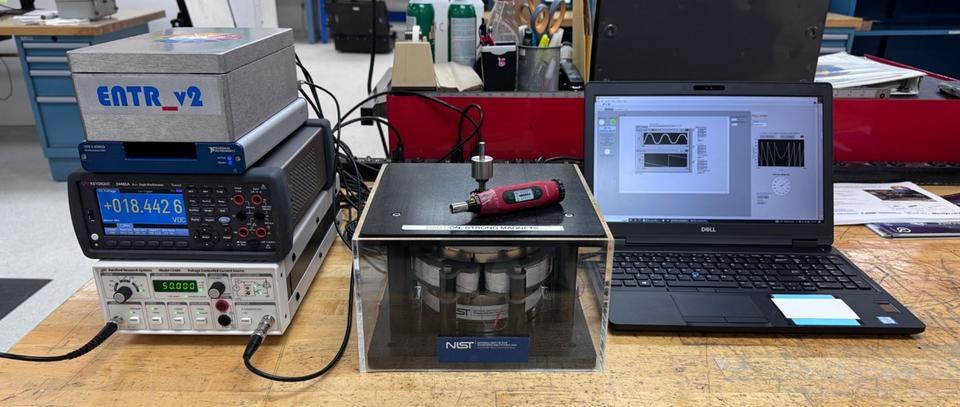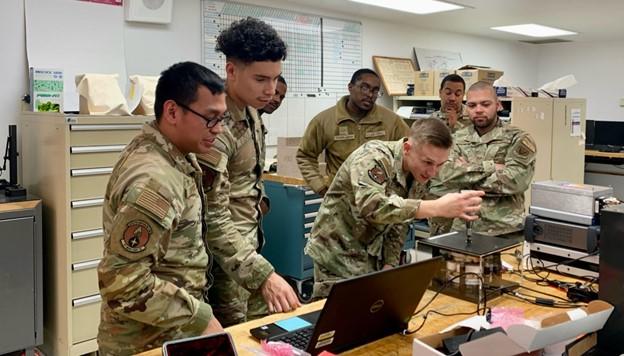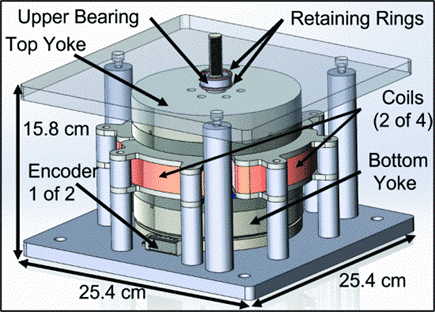Torque Realization
The Technology

Applying the right amount of torque is important in everything from securely tightening screws in home construction to properly stabilizing a helicopter in flight. Following the 2019 redefinition of the International System of Units (SI), researchers have been working to express, or “realize,” the unit of torque, the Newton meter, as a measurable quantity based on fundamental constants of nature. Researchers are adapting the Kibble principle, used to redefine the kilogram, to realize torque in terms of electrical units from quantum physics, promising unprecedented levels of accuracy.
Toward these ends, NIST, in conjunction with the U.S. Air Force, has been developing a new kind of tabletop-sized, self-calibrating device for measuring torque. The device, known as the Electronic NIST Torque Realizer (ENTR), compensates for an applied mechanical torque with a self-calibrated electromagnetic torque. ENTR leverages an assembly of rare earth magnets, coils and low-friction bearings while utilizing a commercial voltmeter, current source and data acquisition system along with custom electronic and mechanical components to generate torque traceable to the quantum-electrical SI to calibrate torque tools, among other uses.
Unveiled in 2022, the first version, known as ENTR_v1, could realize torque ranging from 0.25 to 3 ounce-force-inches (ozf-in), equivalent to 0.0018 to 0.02 newton meters (N·m). Since then, the researchers have developed ENTR_v2, which can realize torque in a much broader range from 1 ozf-in to 140 ozf-in (0.01-1 N·m) accurate to 0.1%. Three ENTR_v2’s are presently in existence and are stationed at NIST, Nellis Air Force Base in southern Nevada, and the tool development company Snap-on.
In August 2024, the Air Force agreed to fund NIST for four more years to develop a large capacity ENTR_v3, which will have a range of (0.01-340 N·m) with 0.5% accuracy. For reference, a sports car outputs about 300 N·m of torque, while a screwdriver for assembling tiny parts in smartphones may have a setting for 0.01 N·m of torque.
Advantages Over Existing Methods

Conventional techniques for measuring torque require regular calibration of both mass and length artifacts. This process often necessitates shipment of heavy mass sets from the end user to calibration labs and then back again. By contrast, the ENTR approach does not require mass and length standards to realize torque, and instead utilizes standards of voltage and resistance traceable to the present definitions of the SI. Avoiding the need for expensive and time-consuming offsite shipments, ENTR can be used on-site in laboratories that already have voltage and resistance standards, lightening logistical burdens and increasing operational efficiency.
Furthermore, ENTR can outperform most low-range commercial torque transducers currently on the market. Traditional strain-gauge torque transducers are transfer standards with uncertainties of approximately 0.25% of torque measured, while ENTR_v2 has 0.1% uncertainty or less.
Applications

Threaded fasteners such as screws, bolts and nuts often need specific amounts of torque to tighten correctly. For example, millions of fasteners are required to build a single commercial jet. A large portion of those are screws requiring a careful amount of torque — not too much, not too little — to ensure optimal fastening without jeopardizing safety. Tools such as torque wrenches can ensure this Goldilocks zone of tightness. Workers must test and calibrate these tools regularly to make sure they are correctly measuring the amount of torque applied to a screw, bolt or nut.
In precision applications, these tools require annual recalibration and recalibration after any accidental drops. However, the time and expense of sending them to specialized calibration labs has proved prohibitive for everyone from mechanics at local auto shops to technicians at airline maintenance hubs. As a result, some mechanics risk working with uncalibrated wrenches, potentially compromising critical torque applications, while others opt to replace their entire torque wrench inventory yearly — a wasteful and costly practice.
ENTR is primarily intended for use as a torque tool calibration device, but the technology can theoretically be adapted for any application where low-uncertainty torque generation is needed. It is possible that this better-performance torque realization device will open the door for advances in precision design, manufacturing and nanotechnology.
Key Papers
Zane Comden, Stephan Schlamminger, Charles Waduwarage Perera, Frank Seifert, David Newell, Jay Hendricks, Barbara Goldstein and Leon Chao. A new spin on Kibble: A self calibrating torque realization device at NIST. euspen’s 22nd International Conference & Exhibition. May/June 2022.
Zane Comden, John Draganov, Stephan Schlamminger, Frank Seifert, Charles Waduwarage Perera and David B. Newell. The design and performance of an electronic torque standard directly traceable to the revised SI. IEEE Transactions on Instrumentation and Measurement. Published online May 25, 2023. DOI: 10.1109/TIM.2023.3279911
Zane Comden, Stephan Schlamminger, Frank Seifert, Kumar Arumugam, Chandra B Shahi, David B Newell and Leon S Chao. Leveraging the revised International System of Units: torque from the fundamental constants. Metrologia. Published 17 September 2025. DOI: 10.1088/1681-7575/ae029a
Key Patents
L.S. Chao and S. Schlamminger. Electronic Torque Realization Apparatus. United States Patent US 12276559-B2. April 15, 2025.
Contacts
-
(301) 975-2416

